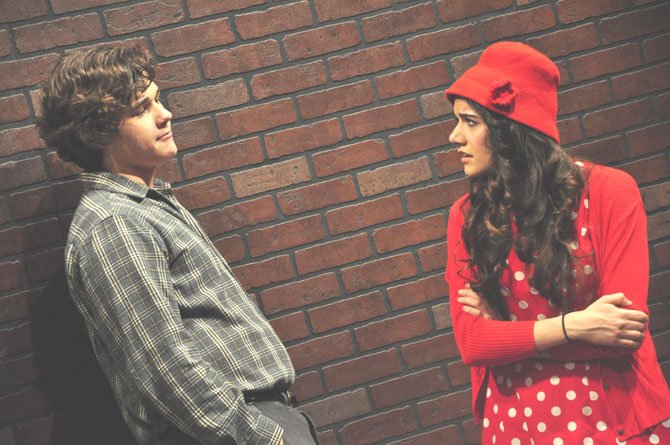Eddie Carbone (played by Damian Leverett) argues with his niece Catherine (played by Lexie Shoaibi) during "A View From a Bridge," which will be presented at McLean High School starting March 21. Photo by Alex McVeigh.
McLean — When McLean High School’s McLean Theatre Company decided to present Arthur Miller’s "A View From the Bridge," the wide open spaces of the regular auditorium just wouldn’t do. For the performances, they decided to use the more intimate confines of the school’s black box theater. The result is a play, a tale of poor Italian immigrants living in the shadow of New York’s Brooklyn Bridge, that happens within a few feet of the audience at all times.
"A View From the Bridge" tells the story of longshoreman Eddie Carbone, his wife and niece and the changes that take hold of their life as a pair of newly arrived immigrants stay at the Carbone’s ground-floor apartment. Eddie Carbone, who at the play’s start is already having trouble accepting change, finds his world thrown upside down when his niece takes a liking to Rodolpho, one of the visitors.
"One of the biggest challenges was to make sure we’re getting as deep into the characters as we do the plot," said Lexie Shoaibi, who plays Catherine, Eddie’s niece. "Working in such an intimate environment probably pushed us as hard as we’ve ever been pushed as actors."
DIRECTOR and McLean theater teacher Amy Poe said the setting was "essential to the closed in feeling that the play gives you."
Max Johnson, who plays Rodolpho, said getting into character was essential for the give and take that comes as the plot unfolds.
"So much of what I do is based off of how Damian [Leverett, who plays Eddie Carbone] or Lexie treats me," he said. "So every moment, whether very intimate, or very awkward, changes a bit from day to day depending on how affectionate Lexie is, or how nasty Damien is to be during our scenes."
Siena Richardson, who plays Eddie’s wife Beatrice, said she felt it important to be comfortable with the characters around her.
"It was important to know how to bounce off of each other, how to react even if things go a little differently than they did last time," she said. "Once we became comfortable, it was much easier to respond in a more natural way."
The black box theater was transformed into a street, the Carbone apartment and a lawyer’s office by stage crew determined to make it look like a true 1950s tenement. The audience is seated on a collection of vintage chairs, and the play’s set up puts them right in the middle of the action.
"With everyone so close, it’s natural to not want to make the audience uncomfortable, but that’s going to happen in the play," Leverett said. "When you’re on a normal stage, you have to be very careful to open up to the audience, but here you can act in a much more realistic manner."
THE CAST AND CREW spent a lot of time trying to re-enact the environment of a 1950s tenement. They watched films such as "On the Waterfront" and "The Godfather" and used an accent coach to help them learn the mannerisms of characters that know varying levels of English.
"We were very concerned with detail, because we know the audience is so close, if things aren’t real, they’ll be able to tell," said Terry Mittelman, stage manager for the production. "We did a lot of research into the state of tenements around that time. For example, we used a lot of wallpaper, because even though we found that fire codes in the 1950s didn’t allow them, we found a lot of landlords used wallpaper anyway."
The apartment is furnished with old radios, magazines, furniture and even a Monopoly game that is from the 1950s. Audience members will be led through a brick panel-lined hallway and actually enter through the front door of the Carbone’s to be led to their seat, fully immersing them in the environment.


